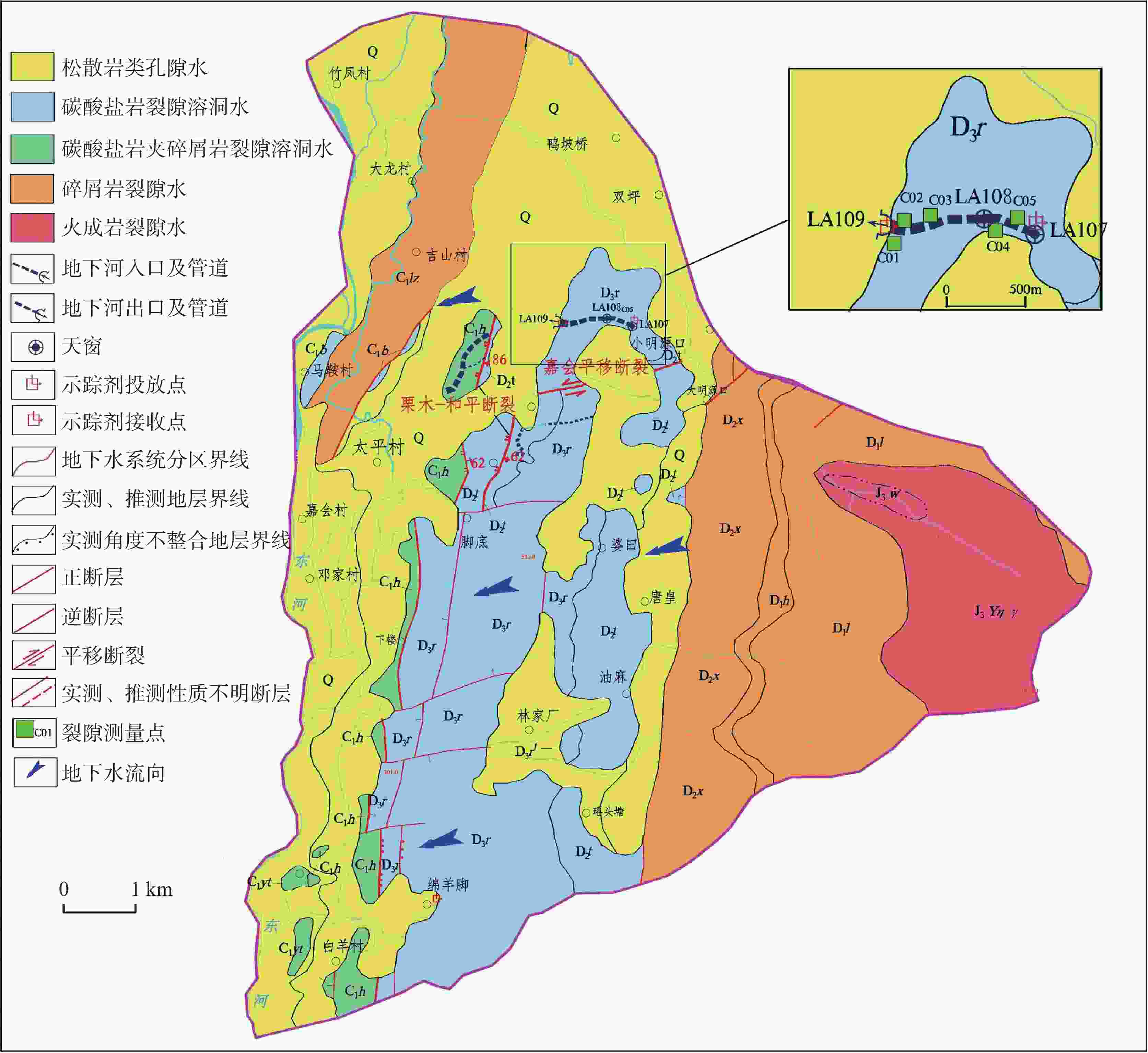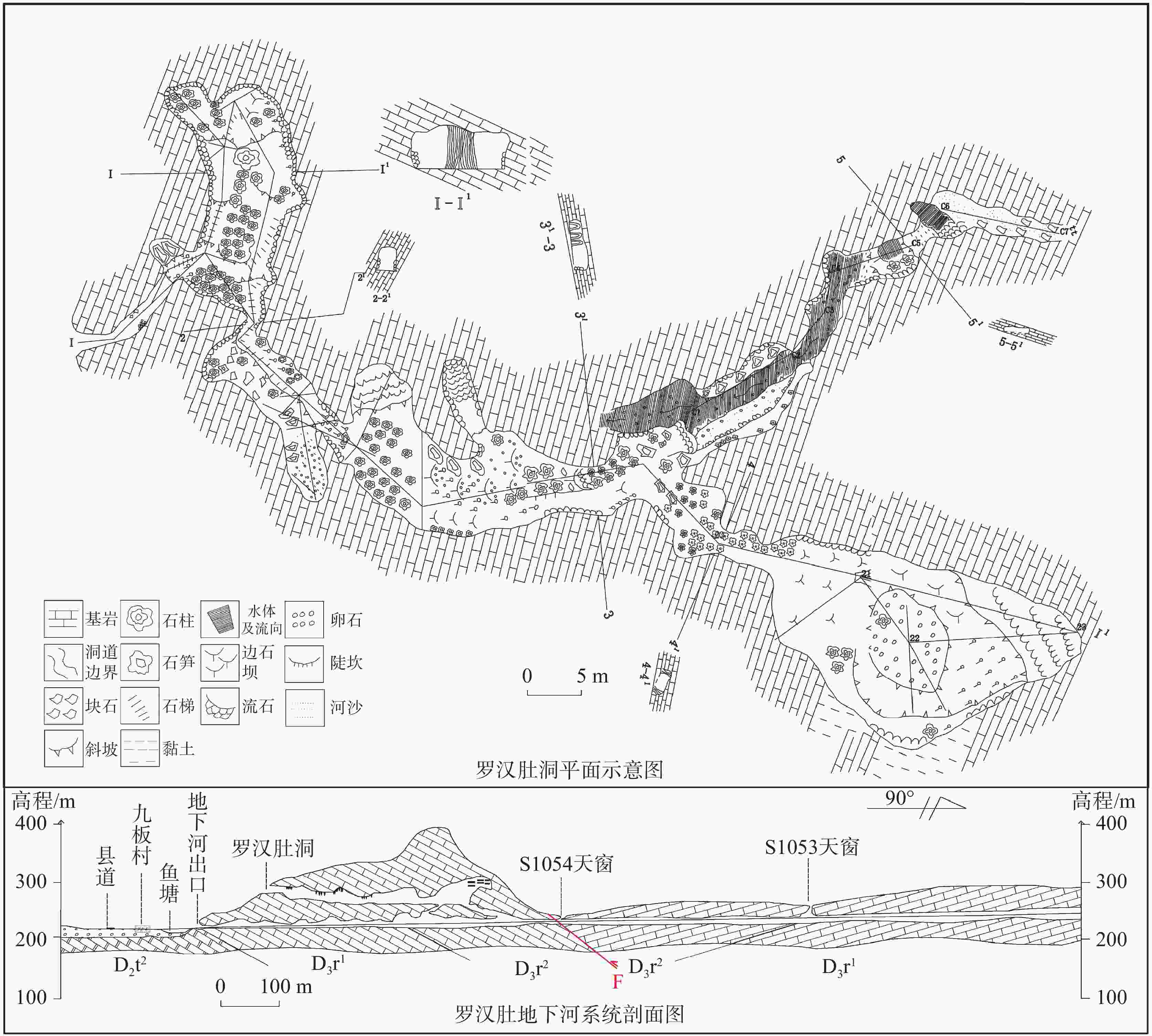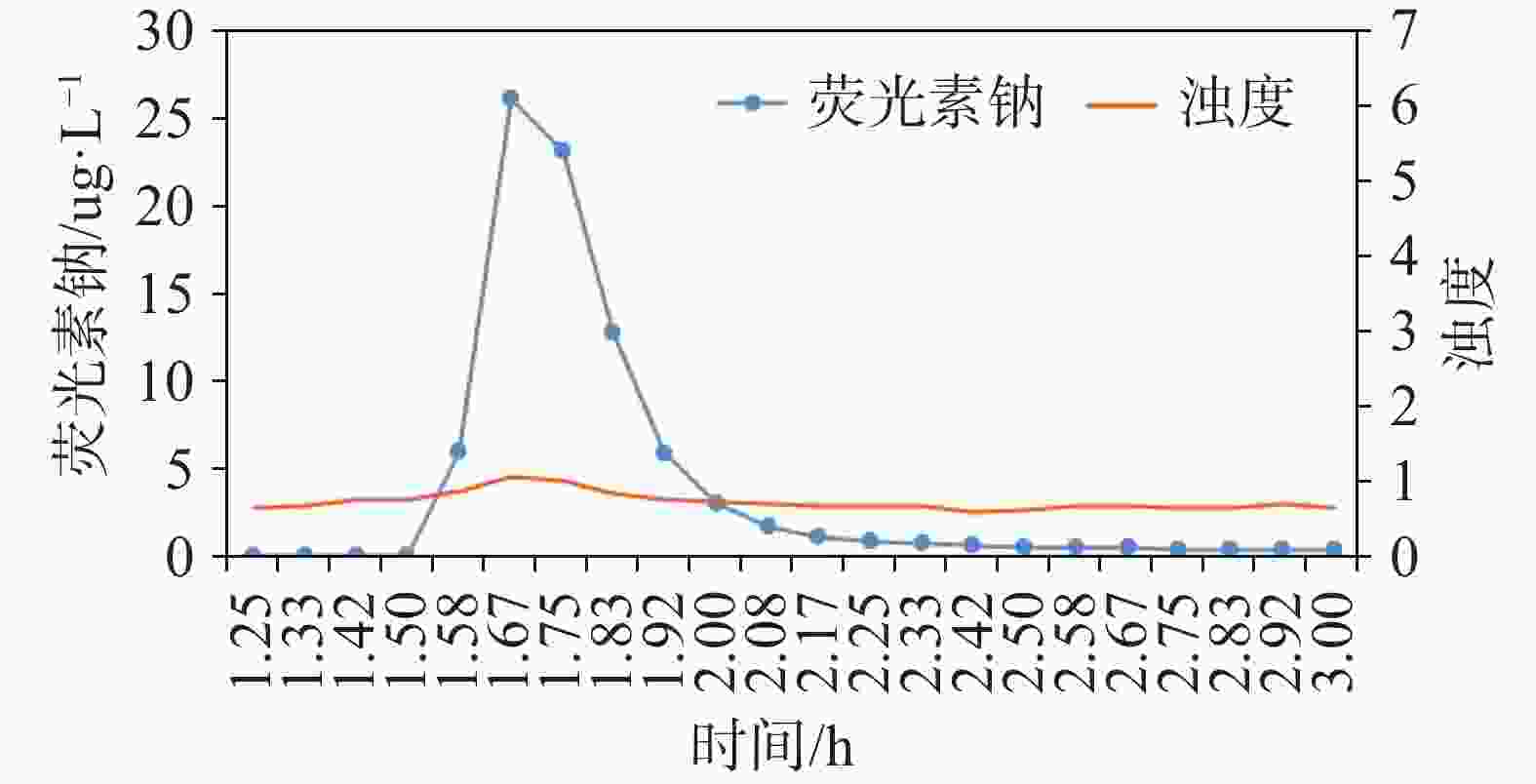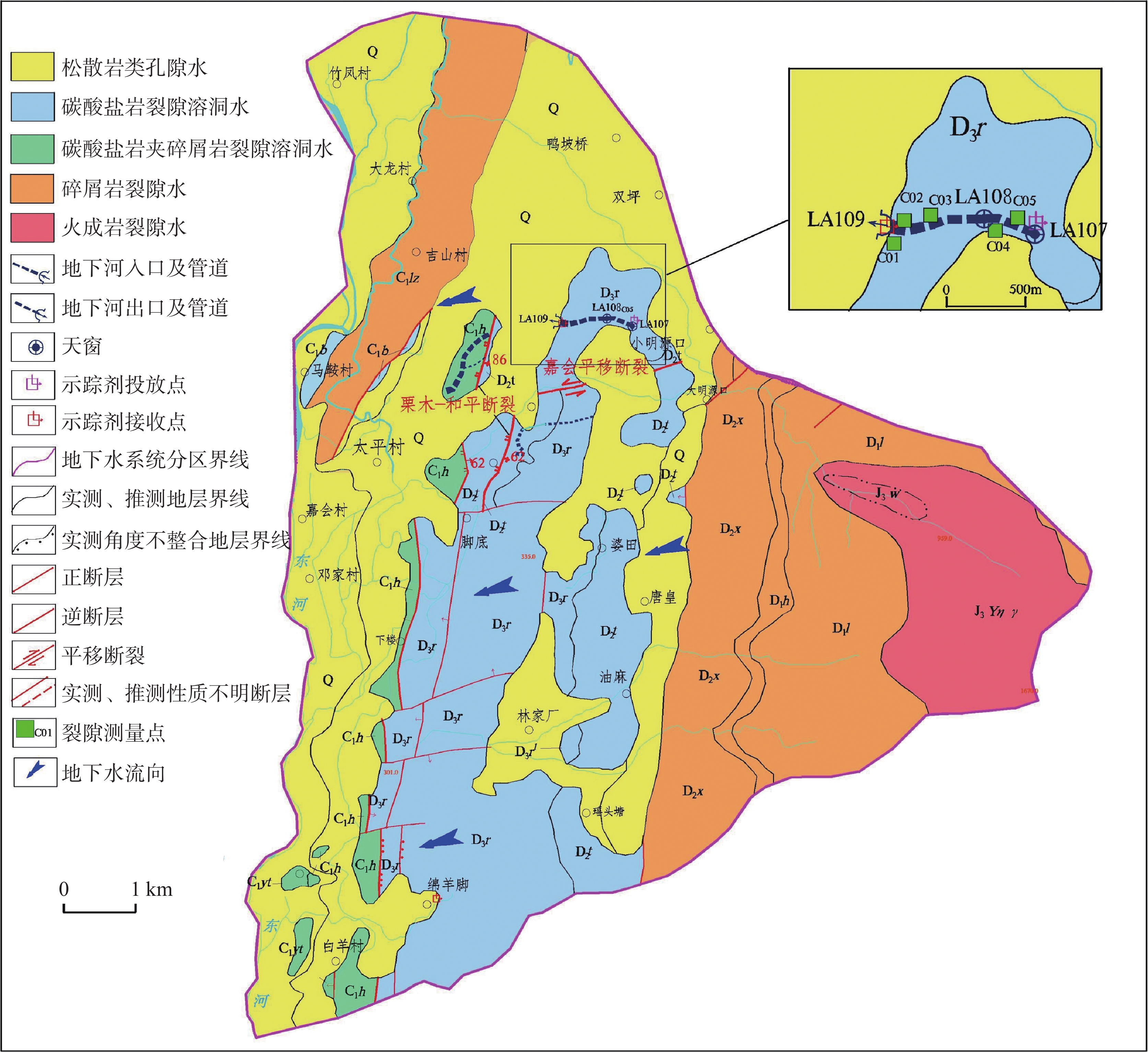Analysis of characteristics and control factors of underground river pipeline based on tracer test and crack measurement-Take Luohandu Underground River as an example.
-
摘要: 我国西南地区岩溶发育十分显著,目前已探明的岩溶地下河达
3066 条。作为地下水资源赋存的主要空间,岩溶管道的展布特征及其发育控制因素的研究具有重要意义。本文以恭城县罗汉肚地下河为研究对象,在区域构造条件分析和洞穴探测的基础上,综合运用示踪试验和裂隙测量方法,揭示了地下河管道的发育展布特征及其控制因素。通过高精度定量示踪试验的曲线特征分析,明确了罗汉肚地下河为单一管道形态。同时,采用统计窗口法对四组裂隙进行了测量,其中三组为构造裂隙,一组为层面裂隙。研究发现,第1组和第4组裂隙的走向与地下河的发育方向基本一致。进一步分析表明,高角度构造裂隙为地下河的补给提供了重要通道。通过计算构造裂隙渗透张量主值,发现5个测量点的渗透张量主值K3的倾向范围为254°至292°,倾角多小于25°。最大渗透张量的方向决定了岩溶地下水的渗流方向,进而控制了地下河管道的发育。本研究通过多种技术手段,不仅系统掌握了地下河管道的展布特征,还深入揭示了地下河形成的控制因素,为后续开展地下河调查及水资源评价提供了重要的科学依据。Abstract:The karst development in southwest China is very remarkable. At present, there are 3066 karst underground rivers that have been proved. As the main space of groundwater resources, it is of great significance to study the distribution characteristics and development control factors of karst pipelines. In this paper, Luohandu underground river in Gongcheng county was taken as the research object, and a 1:50000 hydrogeological survey was carried out. It was found that there was an upper karst cave at the outlet of Luohandu underground river, which was supposed to be the original discharge outlet. The length of the karst cave was 567.9m, and according to the investigation, it was found that the pipeline of the lower underground river was about 1.6km long. According to the regional geological data, Luohandu Underground River is located near the structural belt of Chestnut-Heping fault and Jiahui translational fault, in which Chestnut-Heping fault develops in the north-south direction and Jiahui translational fault develops in the east-west direction. The chestnut-Heping fault is cut in the working area, and the structure controls the development of underground river pipelines.In order to find out the controlling factors of pipeline development and development, groundwater tracing test and fracture measurement are carried out. The tracer test was put into the skylight of the underground river in the upper reaches of the underground river, and the tracer was received only in 1.5 hours. The tracer concentration reached the peak in 1.7 hours, and then began to decrease. It was calculated that the maximum velocity of groundwater between the skylight and the outlet of the underground river was 550.4 m·h−1, and the average velocity was 447.7 m·h−1 , which showed that the underground water flow between the skylight and the outlet of the underground river was closely related to the underground water, and the underground water migration path was relatively smooth, and the karst was developed in the shape of a single pipe. At the same time, four groups of cracks were measured by statistical window method, including three groups of structural cracks and one group of bedding cracks. In order to study the control of cracks on the development of karst pipelines, the statistical analysis of crack measurement results shows that the direction of cracks in the first and fourth groups is basically consistent with the development direction of underground rivers. Further analysis shows that high-angle structural fractures provide an important channel for the recharge of underground rivers. By calculating the principal value of permeability tensor of structural fractures, it was found that the dip directions of the third principal permeability tensor (K3) at five measurement points ranged from 254° to 292°, with dip angles mostly less than 25°. The direction of maximum permeability governs the seepage direction of karst groundwater, and long-term erosion and dissolution along this direction ultimately control the development of the underground river conduit. On the basis of 1: 50000 hydrogeologic survey and regional geological data, this study understands the structural pattern, describes the distribution and spatial characteristics of underground river pipelines in detail based on high-precision tracer tests, and analyzes the control of structural fractures on underground river pipelines by combining fracture measurement and calculation of permeability tensor. Through various technical means, not only the distribution characteristics of underground river pipelines are systematically grasped, but also the controlling factors of underground river formation are deeply revealed, which provides an important scientific basis for the subsequent investigation of underground rivers and water resources evaluation. -
表 1 示踪试验部署情况
Table 1. Deployment of tracer tests
投放地点 至出口距离L/m 投放时间 示踪剂种类 注入方式 投放量M/g LA107天窗 1097 2022-05-30 11:50 荧光素钠 一次性注入 15 表 2 罗汉肚地下河示踪段水力参数
Table 2. Hydraulic parameters of Luohandu underground river tracing section
示踪间段 P/% T/h V/m3 A/m2 DC/m DL/m NR LA107-LA109 72.05 29.01 10445 6.5078 2.8785 2570.7 35631 表 3 罗汉肚地下河发育地层主要裂隙发育情况
Table 3. Development ofmain fractures in Luohandu underground river development strata
裂隙分组 产状 延伸长度/m 隙宽/mm 线密度
/条·m-1结构面类型 充填情况 倾向/° 倾角/° 1 20~40 45~80 1.5~2 0.20~0.75 8 构造裂隙 泥质填充 2 80~148 14~58 >2 0.05~0.68 12 层面裂隙 无填充 3 192~265 40~83 >2 0.05~1.20 10 构造裂隙 无填充 4 273~359 32~73 >2 0.05~1.10 8 构造裂隙 无填充 表 4 罗汉肚地下河裂隙测量渗透张量计算结果
Table 4. Calculation results of permeability tensor in fracture measurement of Luohandu underground river
测量点 渗透张量/m·d-1 渗透主值/m·d-1 渗透主值方向 综合渗透系数
K0/m∙d−1倾向/° 倾角/° C01 1.9315 − 0.1869 − 0.1050 0.648 61.2 84.2 1.206 − 0.1869 1.4104 − 0.0207 1.354 162.8 4.2 − 0.1050 − 0.0207 0.6582 1.998 287.5 4.0 C02 − 0.1863 − 0.9732 − 0.1350 1.540 10.8 7.8 1.949 0.3091 0.0724 − 0.9483 1.819 256.8 71.5 0.9326 − 0.2184 0.2874 2.641 283.2 16.7 C03 2.6695 − 0.4385 0.2672 1.429 231.7 10.8 1.905 − 0.4385 1.8306 − 0.0361 1.666 19.1 75.0 0.2672 − 0.0361 1.4999 2.905 292.5 10.4 C04 2.0564 0.7778 − 0.0377 1.247 316.5 10.8 1.890 0.7778 2.0391 − 0.2081 1.896 91.5 75.0 − 0.0377 − 0.2081 1.9045 2.857 254.5 10.4 C05 1.3275 0.4047 − 0.1757 0.783 345.2 55.1 1.220 0.4047 1.5992 − 0.4779 1.094 111.1 22.2 − 0.1757 − 0.4779 1.0733 2.123 272.3 25.4 注:表中渗透主值从上往下依次为K1、K2、K3,其中K3代表最大渗透张量主值方向。 -
[1] 蒲俊兵. 重庆地区岩溶地下河发育与分布的基本特征[J]. 中国岩溶, 2013, 32(3): 266-279.PU Junbing. Development and distribution of karst subterranean streams in Chongqing, China[J]. Carsologica Sinica, 2013, 32(3): 266-279. [2] 宋晨, 潘晓东, 刘天云, 罗飞, 曾洁, 彭聪, 程瑞瑞, 张文平. 云南省一把伞水库主封堵区岩溶渗漏条件与管道特征分析.[J]. 中国岩溶, 2024, 43(5): 1088-1098. doi: 10.11932/karst2024y033SONG Chen, PAN Xiaodong, LIU Yuntian, LUO Fei, ZENG Jie, PENG Cong, CHENG Ruirui, ZHANG Wenping. Analysis of karst leakage conditions and pipeline characteristics in the main blocked area of Yibasan reservoir, Yunnan.[J]. Carsologica Sinica, 2024, 43(5): 1088-1098. doi: 10.11932/karst2024y033 [3] 袁丙华. 中国西南岩溶石山地区地下水资源及生态环境地质研究[M]. 电子科技大学出版社, 2007.YUAN Binghua . Study on groundwater resources and eco-environmental geology in karst rocky mountain area of southwest China[M]. The University of Electronic Science and Technology, 2007. [4] 普政功, 黄奇波, 吴华英, 李腾芳, 邹昌霈, 廖红为. 漓江峰丛片区高位岩溶洼地洪涝水文过程及有效治理 [J]. 中国岩溶, 2024, 43(4): 831-842.PU Zhenggong, HUANG Qibo, WU Huaying, LI Tengfang, ZOU Changpei, LIAO Hongwei. Flood hydrological process and its effective control measures in the high-altitude depressions of peak-cluster areas in Lijiang River [J]. Carsologica Sinica, 2024, 43(4): 831-842. [5] 《中国北方岩溶地下水资源及大水矿区岩溶水的预测、利用与管理的研究》项目综合组. 中国北方岩溶含水介质研究[J]. 中国岩溶, 1990, 9(4): 318-329. [6] 何宇彬. 关于“喀斯特水系统”研究[J]. 中国岩溶, 1997(1): 68-74.HE Yubin. Research on karst water system[J]. Carsologica Sinica, 1997(1): 68-74. [7] 曹建文, 杨海洋, 王喆, 赵良杰, 林玉山, 栾松, 李录娟. 湖北某抽水蓄能电站建设中地下河系统多元信息综合分析评价[J]. 中国岩溶, 2023, 42(4): 699-710.CAO Jianwen, YANG Haiyang, WANG Zhe, ZHAO Liangjie, LIN Yushan, LUAN Song, LI Lujuan. Comprehensive analysis and evaluation of the multi-information on the underground river system in construction of a pumped-storage hydropower station in Hubei[J]. Carsologica Sinica, 2023, 42(4): 699-710. [8] 章程, 翁金桃, 谢运球. 天津蓟县中上元古界岩溶裂隙介质发育特征及其渗透性研究[J]. 中国岩溶, 1992(4): 24-34.ZHANG Cheng, WENG Jintao, XIE Yunqiu. Development characterristics of karst fracture medium and its permeability study of the upper-middle Proterozoic suberathem in Jixian, Tianjin[J]. Carsologica Sinica, 1992(4): 24-34. [9] 梁彬, 翁金桃, 陶友良, 童长水. 焦作地区碳酸盐岩裂隙发育特征及其水文地质意义[J]. 中国岩溶, 1990(1): 27-35.LIANG Bin, WENG Jintao, TAO Youliang, TONG Changshui. The characteristics of fracture development in carbonate rocks and its significance of hydrogeology in Jiaozuo area[J]. Carsologica Sinica, 1990(1): 27-35. [10] 郭纯青. 中国岩溶生态水文学研究[C]//中国林学会. 2005年中国科协学术年会26分会场论文集(1). 桂林工学院资源与环境工程系, 2005: 3.GUO Chunqing . Study on karst eco-hydrology in China[C]// Chinese Society of Forestry. Proceedings of the 26th Session of the 2005 China Association for Science and Technology Annual Meeting(1). Guilin Institute of Technology Department of Resources and Environment Engineering,2005: 3. [11] 郭纯青, 刘景兰, 王洪涛, 邓欢. 中国南方岩溶地下河系形成演变的链式规律[J]. 地球科学进展, 2004(S1): 153-156.GUO Chunqing, LIU Jinglan, Hongtao Wang, Huan Deng. The China-rules of forming and evolution of underground river system in karst areas in south China[J]. advances in earth science, 2004(S1): 153-156. [12] 郭平战. 韩城矿区岩溶形成机理及其水文地质特征[J]. 地下水, 2015, 37(05): 54-57.GUO Pingzhan. Karst formation mechanism of karst in Hancheng mining area and its hydrogeological characteristics[J]. Ground water, 2015, 37(05): 54-57. [13] 何师意, Michele L, 章程, 汪进良, 李强. 高精度地下水示踪技术及其应用: 以毛村地下河流域为例[J]. 地球学报, 2009, 30(5): 673-678.HE Shiyi , Michele L, ZHANG Cheng , WANG Jinliang, LI Qiang. A high precision underground water Tracing test technique and its applications: A case study in Maocun karst system, Guilin, Guanxi [J]. Acta Geoscientica Sinica, 2009, 30(5): 673-678. [14] 黄芬, 尹伟璐, 胡晓农, 曹建华. 桂林毛村地下河流域雨季与旱季定量示踪分析[J]. 中国岩溶, 2017, 36(5): 648-658.HUANG Fen , YI Weilu, HU Xiaonong, CAO Jianhua. A quantitative analysis of tracing tests for the Maocun subterranean river basin of Guilin during rainy and dry seasons[J]. Carsologica Sinica, 2017, 36(5): 648-658. [15] 易连兴, 卢海平, 赵良杰, 王喆. 鱼泉地下河示踪试验及回收强度法管道结构分析[J]. 工程勘察, 2015, 43(2): 46-51.YI Lianxing, LU Haiping, ZHAO Liangjie, WANG Zhe. Trace tests and conduit structure analysis with recovery intensity in Yuquan underground river[J]. Geotechnical Investigation & Surveying, 2015, 43(2): 46-51. [16] 徐尚全, 王鹏, 焦杰松, 黄山松, 杨平恒. 高精度在线示踪技术在岩溶地下水文调查中的应用[J]. 工程勘察, 2013, 41(2): 40-44.XU Shangquan, WANG Peng, JIAO Jiesong, HUANG Shansong, YANG Pingheng. Application of high-precision online tracer technique in thehydrogeological investigation of karst groundwater[J]. Geotechnical Investigation & Surveying, 2013, 41(2): 40-44. [17] 张祯武, 杨胜强. 岩溶水示踪探测技术的新进展[J]. 工程勘察, 1999(5): 42-45+41.ZHANG Zhenwu, YANG Shengqiang. New progress of karst water tracing detection technology[J]. Geotechnical Investigation & Surveying, 1999(5): 42-45+41. [18] 邹成杰. 岩溶管道水汇流理论研究[J]. 中国岩溶, 1992(2): 29-40.ZOU Chengjie. Study on the confluence theory of karst pipe-flow[J]. Carsologica Sinica, 1992(2): 29-40. [19] 陈余道, 程亚平, 王恒, 蒋亚萍, 黄月群. 岩溶地下河管道流和管道结构及参数的定量示踪: 以桂林寨底地下河为例[J]. 水文地质工程地质, 2013, 40(5): 11-15.CHEN Yudao, CHENG Yaping, WANG Heng, JIANG Yaping, HUANG Yuequn. Quantitative tracing stuy of hydraulic and geometric parameters of a karst underground river: exemplified by the Zhaidi underground river in Guilin[J]. Hydrogeology & Engineering Geology, 2013, 40(5): 11-15. [20] 杨立铮, 刘俊业. 试用示踪剂浓度——时间曲线分析岩溶管道的结构特征[J]. 成都地质学院学报, 1979(04): 44-49.YANG Zhengli, LIU Junye. Analysis of structural characteristics of karst pipeline by tracer concentration-time curve[J]. Science & Technology Edition, 1979(04): 44-49. [21] 张祯武. 岩溶地下水管流场类型与示踪曲线对应关系的研究[J]. 工程勘察, 1991(01): 32-37.ZHANG Zhenwu. Study on the corresponding relationship between flow field types and tracer curves of karst underground water pipes[J]. Geotechnical Investigation & Surveying, 1991(01): 32-37. [22] 杨平恒, 袁道先, 蓝家程, 陈雪彬, 张笑微. 基于在线高分辨率监测和定量计算的岩溶地下水示踪试验[J]. 西南大学学报(自然科学版), 2013, 35(02): 103-108.YANG Pingheng, YUAN Daoxian, LAN Jiacheng, CHEN Xuebin, ZHANG Xiaowei. Tracing test of a karst aquifer based on online. High-resolution monitoring and quantitative calculation[J]. Journal Press of Southwest University, 2013, 35(02): 103-108. [23] 王大纯. 水文地质学基础[M]. 地质出版社, 1986.WANG Dachun . General Hydrogeology[M]. Geological Publishing House, 1986. [24] 沈继方, 史毅虹. 北京西山变玄武岩裂隙发育规律及含水特征[J]. 地球科学, 1985(01): 133-147.SHEN Jifang, SHI Yihong. The Development law and water-bearing charactertics of fractures of variational basalt in Xishan Beijing[J]. EarthSciences, 1985(01): 133-147. [25] Snow D T . Anisotropie Permeability of Fractured Media[J]. Water Resources Research, 1969, 5(6). [26] 蔡昊, 陈植华, 周宏. 裂隙对雾龙洞岩溶发育及地下径流的影响分析[J]. 安全与环境工程, 2015, 22(02): 1-6+38.CAI Hao, CHEN Zhihua, ZHOU Hong. Impact analysis of fracture on the karst developmentand groundwater flow of wulong cave[J]. Safety and Environmental Engineering, 2015, 22(02): 1-6+38 [27] US EPA National Center for Environmental Assessment, Field M . The Qtracer2 Program for Tracer-Breakthrough Curve Analysis for Tracer Tests in Karstic Aquifers and Other Hydrologic Systems[J]. 2002. [28] Lemke D , Schnegg P A , Schwientek M , et al. On-line fluorometry of multiple reactive and conservative tracers in streams[J]. Environmental Earth Sciences, 2013, 69(2): 349-358. DOI: 10.1007/s12665-013-2305-3. [29] 聂艳华, 段文刚, 树锦. 示踪法定量分析水流连通问题[J]. 长江科学院院报, 2013, 30(2): 4. doi: 10.3969/j.issn.1001-5485.2013.02.004NIE Yanhua, DUAN Wengang, SHU Jin. Quantitative analysis of flow connectivity by tracing method[J]. Journal of Yangtze River Scientific Research Institute, 2013, 30(2): 4. doi: 10.3969/j.issn.1001-5485.2013.02.004 [30] 朱学愚, 徐绍辉. 示踪试验在淄博裂隙岩溶水污染治理中的应用[J]. 中国岩溶, 1997, 16(2): 7.ZHU Xueyu, XU Shaohui. Application of tracing test to the remediation of contaminated fracture-karst water in Zibo city[J]. Carsologica Sinica, 1997, 16(2): 7. -





 下载:
下载:





